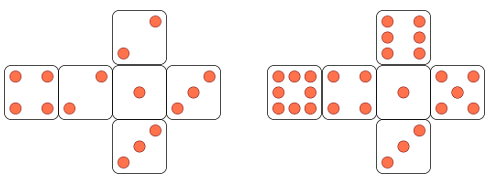What's unusual about these dice is obvious, but what's normal about them?

These dice were discovered by George Sicherman (Buffalo, New York, USA) and were originally reported by Martin Gardner in a 1978 article in Scientific American. When the dice are thrown together, they produce the same probability distribution as a pair of ordinary dice. There are six ways to throw a 7, five ways to throw an 8, etc. Moreover, the Sicherman dice are the only possible alternate arrangement of strictly positive integers that result in the same probability distribution as a pair of ordinary dice.
It is a standard exercise in elementary combinatorics to calculate the number of ways of rolling any given value with a pair of fair six-sided dice (by taking the sum of the two rolls). The table shows the number of such ways of rolling a given value $$n$$:
| $$n$$ | 2 | 3 | 4 | 5 | 6 | 7 | 8 | 9 | 10 | 11 | 12 |
|---|---|---|---|---|---|---|---|---|---|---|---|
| # of ways | 1 | 2 | 3 | 4 | 5 | 6 | 5 | 4 | 3 | 2 | 1 |
A question arises whether there are other ways of relabeling the faces of the dice with positive integers that generate these sums with the same frequencies. The surprising answer to this question is that there does indeed exist such a way. These are the Sicherman dice. Three additional rearrangements having the same probability distribution as a pair of ordinary dice are possible if the dice are allowed to have empty sides.
The table below lists all possible totals of
dice rolls with standard dice and Sicherman dice. One Sicherman die is
coloured for clarity 1–2–2–3–2–4 and the other is all black
1–3–4–5–6–8.
| 2 | 3 | 4 | 5 | 6 | 7 | 8 | 9 | 10 | 11 | 12 | |
| ordinary dice | 1+1 | 1+2 2+1 |
1+3 2+2 3+1 |
1+4 2+3 3+2 4+1 |
1+5 2+4 3+3 4+2 5+1 |
1+6 2+5 3+4 4+3 5+2 6+1 |
2+6 3+5 4+4 5+3 6+2 |
3+6 4+5 5+4 6+3 |
4+6 5+5 6+4 |
5+6 6+5 |
6+6 |
| Sicherman dice | 1+1 | 2+1 2+1 |
3+1 3+1 1+3 |
1+4 2+3 2+3 4+1 |
1+5 2+4 2+4 3+3 3+3 |
1+6 2+5 2+5 3+4 3+4 4+3 |
2+6 2+6 3+5 3+5 4+4 |
1+8 3+6 3+6 4+5 |
2+8 2+8 4+6 |
3+8 3+8 |
4+8 |
Assignment
In this exercise, the outcome of a throw with a pair of dice is represented as a tuple $$(x, y)$$ where $$x \in \mathbb{N}$$ represents the number of pips at the top side of the first die, and $$y \in \mathbb{N}$$ the number of pips at the top side of the second die. Note that we do not limit ourselves in this exercise to six-sided dice, and that the a single die may have sides carrying the same number of pips. A pair of dice is represented a list or tuple of two dice. Your task:
Write a function combinations that takes two dice. The function must return a dictionary that maps all possible outcomes of a throw with the pair of dice (obtained by taking the sum of the two rolls) onto the list of throws that gives a particular outcome. The throws must be listed in increasing order according to the number of pips on the first die.
Write a function distribution that takes two dice. The function must return a dictionary that maps all possible outcomes of a throw with the pair of dice (obtained by taking the sum of the two rolls) onto the number of throws that gives a particular outcome.
Write a function equalDistribution that takes two pair of dice. The function must return a Boolean value that indicates whether or not both pairs of dice produce the same probability distribution of possible outcomes (obtained by taking the sum of the two rolls).
Example
>>> dice6_1 = {1, 2, 3, 4, 5, 6}
>>> dice6_2 = [1, 2, 2, 3, 3, 4]
>>> dice6_3 = (1, 3, 4, 5, 6, 8)
>>> throw = combinations(dice6_1, dice6_1)
>>> throw[8]
[(2, 6), (3, 5), (4, 4), (5, 3), (6, 2)]
>>> throw = combinations(dice6_2, dice6_3)
>>> throw[8]
[(2, 6), (2, 6), (3, 5), (3, 5), (4, 4)]
>>> distribution(dice6_1, dice6_1)
{2: 1, 3: 2, 4: 3, 5: 4, 6: 5, 7: 6, 8: 5, 9: 4, 10: 3, 11: 2, 12: 1}
>>> distribution(dice6_2, dice6_3)
{2: 1, 3: 2, 4: 3, 5: 4, 6: 5, 7: 6, 8: 5, 9: 4, 10: 3, 11: 2, 12: 1}
>>> equalDistribution([dice6_1, dice6_1], (dice6_2, dice6_3))
True
>>> dice8_1 = {1, 2, 3, 4, 5, 6, 7, 8}
>>> dice8_2 = (1, 3, 5, 5, 7, 7, 9, 11)
>>> dice8_3 = (1, 2, 2, 3, 3, 4, 4, 5)
>>> dice8_4 = (1, 2, 5, 5, 6, 6, 9, 10)
>>> dice8_5 = (1, 2, 3, 3, 4, 4, 5, 6)
>>> equalDistribution((dice8_1, dice8_1), (dice8_2, dice8_3))
True
>>> equalDistribution((dice8_1, dice8_1), (dice8_3, dice8_4))
False
>>> equalDistribution((dice8_1, dice8_1), (dice8_4, dice8_5))
True
Resources
Broline D (1979). Renumbering of the faces of dice. Mathematics Magazine 52(5), 312-315.
Brunson BW, Swift RJ (1999). Equally likely sums. Mathematical Spectrum 30(2), 34-36.
Fowler BC, Swift RJ (1999). Relabeling dice. College Mathematics Journal 30(3), 204-208.
Gallian JA, Rusin DJ (1979). Cyclotomic polynomials and nonstandard dice. Discrete Mathematics 27(3), 245-259.
Garnder M (1978). Mathematical Games. Scientific American 238(2), 19-32.